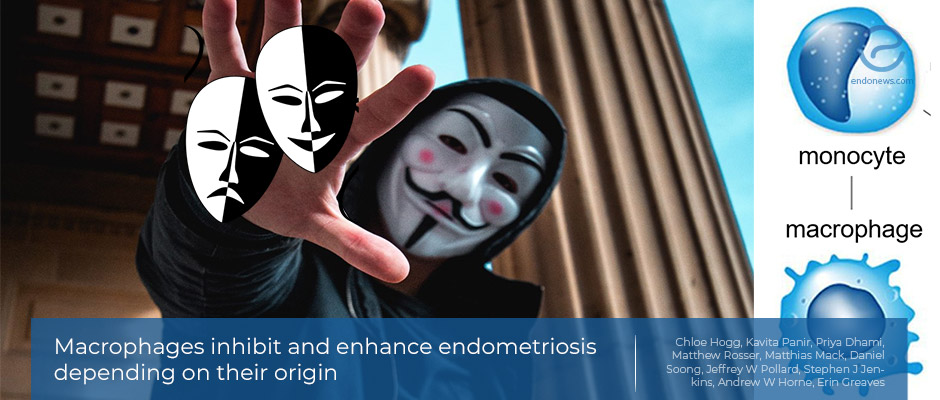The origin of macrophages determines the fate of endometriosis
Feb 12, 2021
The two-faced macrophages
Key Points
Highlight:
- It is now well known that macrophages are involved in the pathology of endometriosis.
- This study proposes a model where eutopic endometrial macrophages have “proendometriosis” while monocyte-derived macrophages are “antiendometriosis” nature.
Importance:
- The study suggests that macrophages are not all the same function, and should be targeted with more precision.
What has been done:
- Modelling of endometriosis in the mouse, which aims to mimic retrograde menstruation.
- Genetic and pharmacological monocyte and macrophage depletion in mice.
- Characterise the ontogeny and function of macrophages in the mouse model.
Results:
- Endometriotic lesion-resident macrophages are derived from eutopic endometrial tissue, infiltrating large peritoneal macrophages are derived from monocytes.
- Endometriosis caused continuous recruitment of monocytes and expansion of C-C chemokine receptor type 2 (CCR2) positive large peritoneal macrophages.
- Depletion of eutopic endometrial macrophages led to smaller endometriosis lesions.
- Inhibition of monocyte recruitment reduced peritoneal macrophage and increased lesion number.
Limitation:
- The mouse model relies on spontaneous attachment of donor endometrial tissue to the peritoneum of mice. This process depends highly on the immune status of the donor mice, which can cause lesion number and size variation between experiments.
Lay Summary
Macrophages are diverse cells. They can present in all tissues of the body to perform crucial functions in immunity, homeostasis, repair and many more. Macrophages change their role depending on signals from their environment, and can therefore have a variety of tissue-specific functions. Recent data suggest that tissue-resident macrophages are derived from embryonic precursors and being maintained by longevity/self-renewal. Increasingly, it is believed that tissue-resident and monocyte-derived macrophages have distinct roles. For example, tissue-resident macrophages have tissue-specific homeostatic functions e.g., clearing dying cells; while monocyte-derived macrophages are recruited to tissues during inflammation and act as an immune response.
The human peritoneal cavity has two main macrophage populations: a predominant population known as large peritoneal macrophages, and a less abundant population, known as small peritoneal macrophages. The large peritoneal macrophages are thought to be the tissue-resident macrophages and can be derived embryonically or replaced by monocytes over time. The small peritoneal population is more diverse and can be derived from monocyte and dendritic cells continually replenished from the blood.
Early evidence from a syngeneic endometriosis mouse model suggested that endometriosis lesions contain donor endometrial macrophages as well as host-derived macrophages. However, the origin and functions of the host-derived macrophages are not clear.
This study by Hogg et al. at The Queen’s Medical Research Institute, The University of Edinburgh, United Kingdom, have investigated the origin of endometriosis lesion-resident macrophages and the dynamics of peritoneal cavity macrophage populations using an endometriosis mouse model. The investigators also use several approached to deplete the different populations of macrophages to assess consequence on endometriosis lesions. The results were published in "Proceedings of the National Academy of Sciences of the United States of America-PNAS".
Endometriosis was induced in the mice by injecting “menses-like” endometrium from donor mice into the peritoneal cavity, the monocytes and macrophages from the donor mice have been labelled hence could be quantified. After two weeks, the endometriosis lesions were collected and analysed by flow cytometry.
The data show that (i) endometriosis lesion-resident macrophages can come from multiple origins; (ii) there was continuous recruitment of monocytes to peritoneal macrophage in the mice with induced endometriosis; (iii) depleting endometrial macrophage led to reduced lesion size, but deficiency of monocytes in mice with induced endometriosis led to an increased number of lesions and transient depletion of monocytes did not affect the endometriosis lesions.
Collectively, these results suggest that different functions of endometriotic lesion-resident macrophages and monocyte-derived macrophages. The former seems to promote endometriosis, while the latter protected the peritoneal cavity when exposed with ectopic endometrial tissue. Therefore, monocyte recruitment or monocyte-derived macrophages may be compromised in women with endometriosis. The findings have important implications for the future development of immunotherapy for endometriosis, which would require specific targeting of “disease-promoting” macrophages while enhancing the “protective” functions other macrophages.
Research Source: https://pubmed.ncbi.nlm.nih.gov/33536334/
immune system pathophysiology macrophage

